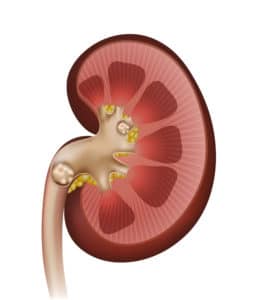Treatment Options for a 9 mm Renal Stone.
If you have any questions, to schedule a consultation or if you need a second opinion, please contact us or call: 646-663-4421
The Choice of Treatment for 8 mm to 10 mm Kidney Stone Depends on the Following Clinical Factors:
- Location of the stone in the kidney
- Presence of infection
- Symptoms: mild, tolerable discomfort or severe pain
- Pregnancy status: ESWL lithotripsy is not an option for pregnant women.
- Existence of other medical problems such as renal insufficiency, solitary kidney or immuno-compromise.
Renal Stones in the Lower Pole of the Kidney
 In general, lower pole kidney stones are more challenging to break. We usually use information about stones size, location and the kidney as well as stone density and stone hardness, as measured by Hounsfield units, to decide on an optimal approach. For kidney stones less than 1 cm (1/2 inch) both ESWL and holmium laser lithotripsy are effective.
In general, lower pole kidney stones are more challenging to break. We usually use information about stones size, location and the kidney as well as stone density and stone hardness, as measured by Hounsfield units, to decide on an optimal approach. For kidney stones less than 1 cm (1/2 inch) both ESWL and holmium laser lithotripsy are effective.
While stone density has no effect on success of holmium laser, dense stones are less likely to break with ESWL. As a result, larger, dense stones have a better chance of being fully fragmented by laser treatment as opposed to ESWL lithotripsy.
Renal Stone in a Caliceal Diverticulum
Calyceal diverticulum is essentially an enclosed space with limited communication to the rest of the renal collecting system. As a result even when stones in the caliceal diverticulum are broken, the fragments have difficulty getting out to being pass with urine. When fragments remain lodged in the caliceal diverticulum the grow and form and even larger stone. Treatment of kidney stones in calyceal diverticulum is a particularly challenging problem.
The preferred treatment options for calyceal stones are laser lithotripsy and PCNL. The choice of procedure would usually be dependent on the exact anatomy of the kidney and the location of the stone in the calyceal diverticulum.
Treatment of a 1 cm Renal Stones at UPJ (ureteropelvic junction)
For kidney stones that are located at the junction of the kidney and the ureter, called the ureteropelvic junction, attempt to pass the stone greater than 5-6 mm would usually be unsuccessful. Certainly stones that 7 mm in greater should be dealt with surgically.
Ureteral stenting provides immediate relief of symptoms. Lithotripsy with ESWL is very successful in breaking stones at UPJ that are less than 1 cm. Most stones that 7 mm, 8 mm, and 9 mm or smaller can be fragmented in one session. Ureteroscopy procedure can be used to break ureteral and UPJ stones using holmium laser. Holmium laser is very effective even for larger stones up to 2 cm.
Ureteroscopy and ESWL Lithotripsy are effective treatment options. The choice between his ESWL and laser options depends on patient’s characteristics, stone size as well as stone density (Hounsfield units).
If you have any questions, to schedule a consultation or if you need a second opinion, please contact us or call: 646-663-4421
Dr. Alex Shteynshlyuger is a board certified urologist in NYC who specializes in treating men and women with kidney stones and ureteral stones.
Find out our office hours or directions to our office.
